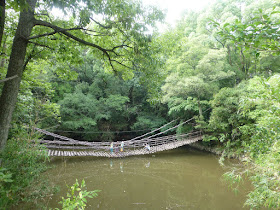As I mentioned recently, Shikoku is an island filled with mountains. It's a pretty hot, humid place, and the isolated nature has left nature isolated. A wide variety of buildings have been used historically around the island given different climates, needs, flora, and fauna. Many of them have been preserved or recreated here.
Getting to Shikoku Mura requires a ride on the local tram and a bit of a walk. But when you reach this driveway, you're there and you can pay your admission.
The path is laid out in a loop, but to match the island's history and the museum's location, it's actually a bit like hiking through the woods at time. And your first stop is a kazurabashi (vine bridge).
It is possible to bypass the bridge, but where's the fun in that? I was hoping to visit Iya Valley, where real vine bridges still exist across a gorge, but weather canceled those plans. This is not a bridge for running across.
Every house is open, and signage is in place that explains the building's original location and key features.
Ooh! A bathroom! ... for display only. Many of the buildings (or the originals they were based on) aren't really that old, but still have an old feel because modern life seems to have taken a good bit of time to reach some parts of Shikoku.
There's an outdoor kabuki theater for performances, but I don't think there were any on the day I was there. I did arrive later in the afternoon so they could have come and gone.
Here's an old sugar mill.
And a rock wall. There are several walls found in the museum for a specific purpose. Wild boar still roam the island (and Japan) and rock barriers like these were a way to protect villages from animal invasion. As far as Japan goes, Shikoku must remain the most diverse and wild.
There are some more modern buildings in the collection, including Okunojima Lighthouse. Okunojima is actually a small island between Shikoku and the main island of Japan which was used as a secret military base to develop and manufacture poison gas during World War II. I visited that island earlier this year.
Near the lighthouse are several other western-style buildings, including the lighthouse keeper's house.
Again, browsing inside is possible, but be careful...
That's a snake on the door. I didn't notice it at first, and I put my hand on the door jam to steady my camera, touching the snake. Needless to say, I was quite frightened. Shikoku has two poisonous snake species, one of which is very aggressive. This must have been the shy one, as it didn't attack me when I touched it. It didn't run away either, because I had plenty of time to get this photo.
Some of the western-style buildings have Japanese interiors, similar to much of today's housing in Japan. And one of them had a wasp's nest in one of the rooms! These houses truly are open.
The path, as you can see, is quite wild. And at times confusing, even with an English map. I do wish the route itself had a little better signage, mainly later on where some paths split or cross. The building in the right-hand photo is a bark steaming hut, used to separate bark from the tree during the paper-making process.
This building had an old calendar. It's good in non-leap years when June 5 is a Sunday.
Flower.
Path.
Japanese buildings are rather plain and utilitarian. There are some added design elements that add beauty to the simplistic construction, but houses small so there isn't much room for grand staircases and bay windows. But it's still interesting to see the way people lived decades or centuries ago.
There are several manufacturing buildings in the "town" including a museum.
There's a stone storehouse and arched bridge that came from the northeastern area of Shikoku, most likely in the area of Marugame. They date to the Meiji period, and are pretty unique in Japan. The bridge has a carp and Chinese lion dog carved into it, the only such bridge in Japan.
There's a nice line of old sake jugs complete with brewer's marks.
Following the wall of bottles will lead you to an old brewery.
A rusty old bike sits abandoned out front.
Inside is a small display of sake barrels and labels.
No longer sea-worthy, this old boat sits outside a fisherman's house.
His gear is stored properly, ready to go back out again.
The last building is definitely influenced by western architecture, and serves as a shop and offices.
Back outside the grounds, nestled in some trees is a small house with a waterwheel where you can have a light meal.
This is a very well done outdoor museum with excellent English signage and fairly-unique structures. It's a pleasant location and certainly worth the time and effort for those interested in architecture or Shikoku's history.
Up Yashima mountain, behind the park, are some attractions including a monument, viewpoints, a temple, and a small aquarium. Yashima can be reached by the once-hourly shuttle bus from JR and Kotoden Yashima stations.
Access is possible by JR lines, using Yashima Station (15 minutes plus 15 minute walk, about 2 trains per hour), but Kotoden Yashima Station is closer (about 20 minutes plus 5 minute walk). The Kotoden line takes longer and costs more, including a transfer of trains; trains on the second leg of the journey run about three times per hour.
The park is open 8:30-17:30 (18:00 April-October) and admission is 800 yen (1000 yen including the art gallery).








































No comments:
Post a Comment